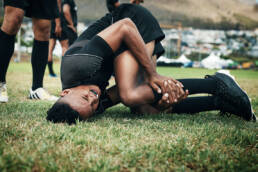Scoliosis, a condition characterized by the sideways curvature of the spine, can significantly affect one’s posture, mobility, and overall quality of life. Although it is commonly diagnosed in childhood or adolescence, scoliosis can persist into adulthood and may progress over time. For individuals living with scoliosis, physical therapy offers an effective, non-invasive solution, especially in mild to moderate cases.
In this blog, Dr. Mansi Dua, DPT, C2 Schroth Scoliosis Method Certified, explores the role of physical therapy in managing scoliosis. We’ll cover the key goals of physical therapy, common techniques and exercises, specialized programs, and why individualized treatment is crucial for successful outcomes.
Understanding Scoliosis: A Brief Overview
Before diving into the specifics of physical therapy for scoliosis, it’s important to understand the condition itself. Scoliosis involves an abnormal lateral curvature of the spine, which can vary in terms of severity and type. The three main types of scoliosis include:
- Idiopathic Scoliosis: The most common form, which usually arises in adolescence without a known cause.
- Congenital Scoliosis: Caused by abnormal vertebral development before birth.
- Neuromuscular Scoliosis: Associated with conditions like cerebral palsy, muscular dystrophy, or spinal cord injuries.
The severity of scoliosis is often measured using the Cobb angle, which indicates the degree of spinal curvature. In mild cases, the curve is less than 20 degrees, while moderate cases range between 20 and 40 degrees. Severe cases involve curves greater than 40 degrees and may require surgical intervention.
Why Physical Therapy for Scoliosis?
Physical therapy is particularly effective in managing mild to moderate scoliosis. By using targeted exercises and specialized techniques, physical therapy can help alleviate pain, improve posture, enhance flexibility, and prevent the progression of spinal curvature. However, it’s essential to understand that physical therapy for scoliosis is not a “one-size-fits-all” solution. The program must be tailored to the individual’s specific curve type, severity, and overall physical condition.
Goals of Physical Therapy for Scoliosis
The primary objective of physical therapy for scoliosis is to improve a patient’s overall function and quality of life. To achieve this, therapy programs often focus on the following key goals:
Improve Posture and Spinal Alignment
Scoliosis can lead to imbalances in spinal alignment, causing poor posture, asymmetry, and compensatory movements. One of the main goals of physical therapy is to correct or manage these postural imbalances. Therapists use exercises that emphasize symmetry and spinal alignment to promote better posture. These exercises focus on lengthening the concave side of the curve and strengthening the muscles on the convex side to create better balance.
Strengthen Core Muscles
A strong core plays a vital role in supporting the spine and maintaining proper alignment. Physical therapists design core-strengthening exercises that target the abdominal, back, and pelvic muscles. A stronger core not only helps stabilize the spine but also reduces the strain on the surrounding muscles, which can mitigate pain and discomfort associated with scoliosis.
Increase Flexibility
Flexibility is crucial in maintaining spinal mobility and preventing further curvature. Patients with scoliosis often experience stiffness in the muscles surrounding the spine, hips, and shoulders. Physical therapy includes stretching exercises to improve flexibility in these areas, allowing for more balanced and functional movement patterns.
Pain Management
Scoliosis-related pain can be managed through a variety of techniques employed by physical therapists. These may include the use of modalities such as heat, ultrasound, electrical stimulation, and manual therapy to alleviate muscle tension and pain. In addition, therapeutic exercises can help reduce the strain on the spine, relieving discomfort caused by scoliosis.
Education on Body Mechanics
An essential component of physical therapy for scoliosis is educating patients on proper body mechanics. Patients learn how to manage scoliosis in their daily activities, including how to lift, carry, and perform other movements in ways that minimize strain on the spine. This education empowers individuals to take control of their condition and make adjustments that promote long-term spine health.
Common Techniques and Exercises for Scoliosis
Physical therapy programs for scoliosis are highly individualized and may include a combination of the following techniques and exercises:
Targeted Stretches
Stretching is a key component of scoliosis therapy because it helps release tension in tight muscles and improves range of motion. Stretches typically target the back, hips, and legs, with a focus on elongating the concave side of the curve. Some common stretches include:
- Side bends: Stretch the muscles along the concave side of the spine.
- Cat-cow stretch: Improves spinal flexibility by alternating between spinal flexion and extension.
- Hamstring stretches: Loosen tightness in the legs, which can affect pelvic alignment and, in turn, the spine.
Strengthening Exercises
Core strengthening is essential for stabilizing the spine and reducing scoliosis progression. Exercises often target the deep abdominal muscles, spinal extensors, and gluteal muscles. Common strengthening exercises include:
- Planks: Help build core stability by engaging the entire abdominal region.
- Bridges: Strengthen the lower back and glutes to support spinal alignment.
- Superman exercises: Focus on the spinal extensors and core stability by lifting the arms and legs while lying face down.
Postural Training
Postural awareness and retraining are crucial for managing scoliosis. Patients learn exercises to improve their posture, focusing on maintaining neutral spinal alignment throughout the day. These exercises may involve using mirrors or props to help patients visualize their posture and make necessary adjustments.
Breathing Techniques
In scoliosis, the curvature of the spine can sometimes restrict lung capacity, particularly when the ribcage is involved. Physical therapy may include breathing exercises to expand lung capacity and improve breathing efficiency. These exercises often focus on diaphragmatic breathing, which can support better spinal alignment.
Functional Activities
To improve the patient’s ability to perform daily tasks, physical therapists incorporate functional activities into the treatment plan. These activities mimic movements required in everyday life, such as bending, lifting, and reaching, but are adapted to encourage better posture and movement patterns.
Specialized Physical Therapy Programs for Scoliosis
While traditional physical therapy can be highly effective, certain specialized programs have been developed specifically for scoliosis. These programs take a more targeted approach to address the unique challenges of scoliosis patients.
The Schroth Method
The Schroth Method is one of the most recognized physical therapy approaches for scoliosis management. Developed by Katharina Schroth in the 1920s, this method focuses on elongation, postural correction, and breathing techniques. Dr. Mansi Dua, C2 Schroth Scoliosis Method Certified, utilizes this approach to help patients correct their spinal curvature and improve their overall function.
Key principles of the Schroth Method include:
- Postural awareness and correction: Patients are taught to identify their specific curve pattern and learn exercises that promote symmetry.
- Breathing techniques: The method incorporates rotational breathing, which helps expand the chest and improve lung capacity on the concave side of the curve.
- Elongation and stabilization: Exercises focus on elongating the spine and strengthening the muscles that support spinal alignment.
The Schroth Method is highly individualized, with exercises tailored to each patient’s specific curve type and severity.
Yoga and Pilates for Scoliosis
Both yoga and Pilates can be adapted to suit individuals with scoliosis, offering additional ways to enhance flexibility, strength, and body awareness. These practices emphasize core strength, balance, and controlled movements, which can complement traditional physical therapy programs.
- Yoga: Involves poses that lengthen and strengthen the spine, improving posture and flexibility. Poses such as mountain pose, downward dog, and triangle pose can be beneficial for scoliosis patients.
- Pilates: Focuses on core stability and controlled movements. Exercises like the Pilates roll-up, pelvic tilts, and leg lifts can help improve spinal alignment and reduce discomfort.
Considerations for Physical Therapy in Scoliosis Management
When it comes to scoliosis, there is no one-size-fits-all solution. Every scoliosis patient presents unique challenges, and the treatment plan must be customized to meet the individual’s needs. Key considerations include:
Individualized Treatment Plans
The severity of scoliosis, the type of curvature, and the patient’s overall health are critical factors that influence the physical therapy approach. Tailoring the program to address these factors ensures that patients receive the most effective care.
Monitoring Progress
Regular assessments are essential to track the patient’s progress and make necessary adjustments to the treatment plan. As patients improve in strength, flexibility, and posture, physical therapists may modify the exercises to continue challenging the patient while minimizing the risk of injury.
Consistency and Commitment
Physical therapy for scoliosis requires a long-term commitment from patients. Consistency in performing exercises and maintaining good posture is key to preventing the progression of scoliosis and improving quality of life.
Conclusion: The Role of Physical Therapy in Scoliosis Care
Physical therapy plays a crucial role in managing scoliosis, particularly in mild to moderate cases. Through targeted exercises, specialized techniques like the Schroth Method, and personalized treatment plans, patients can achieve improved posture, reduced pain, and better overall function.
At Denver Physical Medicine & Rehab, Dr. Mansi Dua and her team are dedicated to providing comprehensive care for scoliosis patients. By using a combination
of traditional and specialized techniques, we help patients take control of their condition and live a more active, pain-free life.
If you or a loved one has scoliosis and would like to explore the benefits of physical therapy, contact us today to schedule a consultation with Dr. Mansi Dua, DPT, C2 Schroth Scoliosis Method Certified.
Contact Denver Physical Medicine & Rehab to schedule an appointment with Dr. Mansi Dua and begin your journey toward better spine health and improved quality of life!
Ready for an expert opinion? Get in touch today!
Discover how physical therapy can help manage scoliosis in mild to moderate cases, along with other ways it offers healthcare solutions. Learn more from Dr. Mansi Dua, DPT, C2 Schroth Certified.
Like this article? Spread the word!
Related Posts
April 15, 2025
Spring into Motion: Why Now is the Perfect Time to Start Physical Therapy
Discover why spring is ideal for starting physical therapy. Custom rehab, massage therapy…
April 15, 2025
Spring Sports Conditioning: Rehab Tips for Runners, Cyclists & Golfers in Denver
From knee pain to swing mechanics, get ahead of spring sports injuries. PT tips for…
March 10, 2025
Comprehensive Physical Therapy at Denver Physical Medicine & Rehab
Discover expert physical therapy services at Denver Physical Medicine & Rehab. Our…





